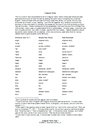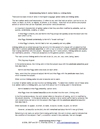Verbs
Links and learning materials about English verbs and how to use them correctlyVerbs, simply defined, are words that show an action or state of being. Because they can be used in so many different ways, verbs are quite possibly the most complex and confusing aspect of English. To help my students make sense of them, I have developed a series of “Understanding Verbs” handouts that I use along with numerous exercises. The information on this page is taken from the first of these, Understanding Verbs I (link to PDF). It covers basic topics such as the five forms of verbs, regular verbs vs. irregular verbs, and the characteristics of participles.
Related Resources
Understanding Verbs I (PDF): A printer-friendly version of this page
Irregular Verbs: A comprehensive list of irregular verbs in English with notes and quizzes
Understanding Verbs II (PDF): Action verbs and linking verbs
The Five Forms of English Verbs
The first step in understanding the complex uses of verbs is to know their different forms: infinitive, present tense, past tense, past participle, and present participle.
Infinitives
*to be
*to have
*to do
to listen
to look
*to go
*to take
*to give
Present Tense
is, are (am)
has, have
does, do
listens, listen
looks, look
goes, go
takes, take
gives, give
Past Tense
was, were
had
did
listened
looked
went
took
gave
Past Participles
been
had
done
listened
looked
gone
taken
given
Pres. Participles
being
having
doing
listening
looking
going
taking
giving
Infinitives
Infinitives are formed by adding to in front of the basic form of the verb, but in some situations, to is omitted. Even though they are verb forms, infinitives don’t function as verbs in sentences; they play other grammatical roles.
Present Tense Forms
There are two verb forms in the present tense—one used with singular subjects, and one used with plural subjects. The verb to be is unique in that it has three present tense forms, and it has both singular and plural forms in the past tense. (It is extremely important to be able to easily recognize the forms of to be and to recognize that they are verbs: is, are, am, was, were, been, being. Be sure to memorize them.)
The student is in the classroom. [The subject student takes the singular verb form.]
The students are in the classroom. [The subject students takes the plural verb form.]
I am in the classroom. [The subject I takes the special form am.]
Participles
You can remember participles by thinking of them as only partial verbs. To function as verbs in a sentence, they must have helping verbs. Their names are misleading; since participles must have helping verbs to indicate their tense (past, present, or future), they have no true tense by themselves.
She has taken the test. [The helping verb has makes the verb present (perfect) tense.]
She had taken the test. [The helping verb had makes the verb past (perfect) tense.]
She will have taken the test. [Will have makes the verb future (perfect) tense.]
Irregular Verbs
For irregular verbs (marked with an asterisk above), the past tense and past participle forms are different, but for regular verbs, the past tense and past participle forms are both formed by adding –ed and look exactly the same. However, they can always be distinguished by the context of their use. If an –ed form is acting as a single verb in conjunction with a subject, it is a past tense verb; if it has a helping verb or is acting in some other way (e.g., as a modifier), it is a past participle.
See the Irregular Verbs page for detailed information and an extensive list of irregular verbs in English.
Complete Verbs vs. Incomplete Verbs
Within the five basic forms of verbs, there is an important distinction to be made: the difference between what I like to call “complete” and “incomplete” verb forms.
Complete verbs (technically called finite verbs when they are paired with a subject) are verbs that have a tense: past, present, or future. To actually function as a verb within a sentence, a verb must be complete. The most obvious examples of complete verbs are the present tense and past tense forms, but the addition of helping verbs can give participles a tense:
Our DNA determines many things about us. (Our genes determine many things about us.)
The doctor determined the cause of the illness.
The scientist has determined the source of the outbreak.
Our facial features are determined by our DNA.
The commission is determining the best way to confront the problem.
All of the verbs in these sentences are examples of complete verbs. The present tense forms determines and determine are the verbs for the subjects DNA and genes, the past tense form determined is the verb for the subject doctor, the present tense helping verb has and the past participle determined form the verb for the subject scientist, the present tense helping verb are and the past participle determined form the verb for the subject features, and the present tense helping verb is and the present participle determining form the verb for the subject commission.
Incomplete verbs, namely participles and infinitives, do not act as verbs by themselves. When they don’t have helping verbs, participles play other grammatical roles within a sentence, just as infinitives do:
The determined doctor found a way to cure her patient.
Determined to find the answer, the scientist worked all night long.
The outcome determined by the judges conflicted with the voters’ desires.*
Luck is often the determining factor in scientific discoveries.
In these sentences, the past participle determined, the present participle determining, and the infinitive to cure are acting as adjectives, and the infinitive to find is acting as an adverb. Because it is acting as a modifier here, determined must be a past participle, not a past tense verb. (The verbs in these sentences are found, worked, conflicted, and is.)
* The phrase “determined by the judges” is a derivative of the clause “The outcome was determined by the judges.” It might be helpful to think of this sentence as a combination of that clause and “The outcome conflicted with the voters’ desires.”
Determining the cause of an illness is the first step toward finding a cure.
To determine the best solution to a problem often requires patience.
In these sentences, the verb forms in bold are all acting as nouns: the present participle determining is the subject of the verb is, the present participle finding is the object of the preposition toward, and the infinitive to determine is the subject of the verb requires.
Only present participles and infinitives, not past participles, can act as nouns. Present participles acting as nouns are called gerunds.
Additional Resources
 Along with the material on this page from Understanding Verbs I, I give my students this comprehensive list of irregular verbs in English that I compiled from a variety of sources. I don’t expect them to memorize this list, but it can serve as a handy reference source if they’re not sure of the correct way to conjugate a verb. This quiz on irregular and confusing verbs can be used in conjunction with the list; in choosing the verbs to include, I focused on verbs that are important to know and/or often conjugated incorrectly.
Along with the material on this page from Understanding Verbs I, I give my students this comprehensive list of irregular verbs in English that I compiled from a variety of sources. I don’t expect them to memorize this list, but it can serve as a handy reference source if they’re not sure of the correct way to conjugate a verb. This quiz on irregular and confusing verbs can be used in conjunction with the list; in choosing the verbs to include, I focused on verbs that are important to know and/or often conjugated incorrectly.
 The next handout in the series, Understanding Verbs II, focuses on the difference between action verbs and linking verbs, along with the issue of whether an adjective or adverb is appropriate for a given clause depending on the type of verb it has.
The next handout in the series, Understanding Verbs II, focuses on the difference between action verbs and linking verbs, along with the issue of whether an adjective or adverb is appropriate for a given clause depending on the type of verb it has.
More Understanding Verbs handouts will be added to this site as I have time to revise them.
© 2004 and 2008 C. Brantley Collins, Jr.